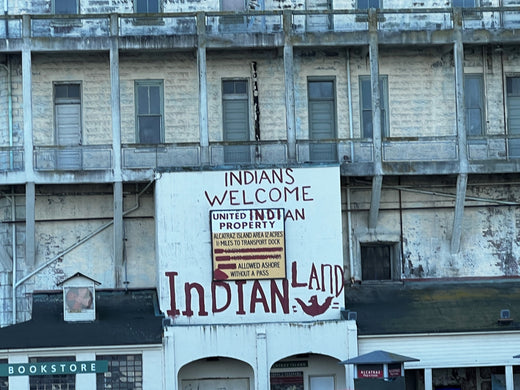
The Untold Story of Alcatraz Island: A Native American Movement for Sovereignty
During a recent trip to San Francisco, my family and I embarked on a ferry tour around the picturesque San Francisco Bay. As we circled Alcatraz Island, I noticed the word "Indian" boldly painted on a couple of the buildings. Intrigued, I captured photographs of the scene to reflect on later. Once I returned home, my curiosity led me to research the story behind this striking graffiti, and here is what I discovered.
Alcatraz Island is best known for its infamous prison and dramatic location in San Francisco Bay. However, beyond its history as a federal penitentiary lies a powerful narrative of Native American resistance and activism that continues to resonate today. During the occupation of 1969–1971, Native activists transformed Alcatraz into a symbol of reclamation and sovereignty—even as their ultimate goal of regaining the island was never realized.
The Occupation of Alcatraz: A Bold Claim to Ancestral Rights
On November 20, 1969, a group of Native American activists calling themselves the "Indians of All Tribes" landed on Alcatraz Island. Their mission? To claim the island in the name of Indigenous peoples, citing the 1868 Treaty of Fort Laramie, which promised the return of abandoned federal land to Native tribes. With the closure of the Alcatraz prison in 1963, the activists argued that the island qualified under this agreement.
Led by Native students and activists, the occupation was more than a protest; it was a call to action. The group envisioned transforming Alcatraz into a cultural, educational, and ecological center for Native Americans. Graffiti scrawled across the island, such as "Indians Welcome" and "Indian Land," declared the occupiers’ message loud and clear.
Why Alcatraz Was Never Returned
Despite the boldness of their claim, the federal government did not return Alcatraz to Native control. Here’s why:
1. Federal Ownership and Legal Challenges
The U.S. federal government maintained that Alcatraz was national property, not subject to reclamation under the Treaty of Fort Laramie. The treaty applied primarily to land in the Great Plains, not to California’s federal holdings. The government resisted setting a precedent that could open the door for further Native land claims nationwide.
2. Government Resistance to Sovereignty Movements
While President Nixon’s administration showed some sympathy toward Native American self-determination, it remained steadfast in its stance that Alcatraz’s return was not feasible. The government instead offered alternative lands and support for Native cultural initiatives elsewhere, but these offers fell short of the occupiers' vision.
3. Internal Challenges During the Occupation
As the occupation stretched on for 19 months, it faced significant challenges. Resource shortages, internal divisions, and external pressures weakened the movement’s momentum. While the initial activists were students and organizers with a clear mission, the island later attracted individuals whose priorities did not align with the original goals. This diminished the effectiveness of the occupation.
4. Strategic and Economic Interests
The federal government viewed Alcatraz as a valuable site for tourism and development, particularly given its location in San Francisco Bay. This conflicted with the occupiers’ plans to develop the island into a Native cultural center. Ultimately, economic and strategic interests prevailed.
The End of the Occupation
On June 11, 1971, federal authorities forcibly removed the remaining occupiers from the island, marking the end of the occupation. However, the movement’s legacy was far from over.
A Legacy of Change and Inspiration
Although Alcatraz was not returned, the occupation achieved something profound: it ignited a wave of Native American activism and drew national and international attention to Indigenous issues. The occupation helped:
- End the Indian Termination Policy: The federal government began moving away from policies aimed at assimilating Native peoples and instead adopted policies supporting tribal self-determination.
- Raise Awareness of Native Struggles: The occupation placed Native American rights and sovereignty in the spotlight, influencing public opinion and policy.
- Inspire Future Movements: The reclamation efforts at Alcatraz inspired other successful land returns, such as the Taos Pueblo’s reclamation of Blue Lake and the Yakama Nation’s reclaiming of Mount Adams.
Today, the graffiti left by the activists remains on Alcatraz, preserved as a historical testament to their fight. For visitors, these markings serve as a powerful reminder of the resilience and determination of Native Americans in their ongoing struggle for justice and sovereignty.
Conclusion: Alcatraz as a Symbol of Resistance
The story of the Alcatraz occupation is a story of hope, resilience, and the fight for recognition. While the island was never returned, the movement’s impact endures, shaping policies and inspiring generations of activists. Alcatraz’s graffiti and the stories behind it remind us of the importance of amplifying Indigenous voices and continuing the work of righting historical wrongs.
In many ways, the struggles of Native Americans for recognition and sovereignty parallel those of Indian indentured servants who were brought to distant lands like Fiji during the colonial era. Both groups faced displacement, exploitation, and the erasure of their identities. Yet, both also demonstrated remarkable resilience and a determination to reclaim their narratives. Just as Native Americans used Alcatraz as a platform to assert their rights, indentured servants and their descendants found ways to preserve their cultures and fight for their dignity. The resilience of these communities serves as a reminder of the enduring power of human spirit and the importance of continuing the fight for justice and equality.
The next time you visit Alcatraz, take a moment to reflect on the layers of history that shaped it. Beneath the tales of infamous criminals lies a legacy of courage and a dream for sovereignty that still calls out from the island’s windswept shores.






Leave a comment
This site is protected by hCaptcha and the hCaptcha Privacy Policy and Terms of Service apply.